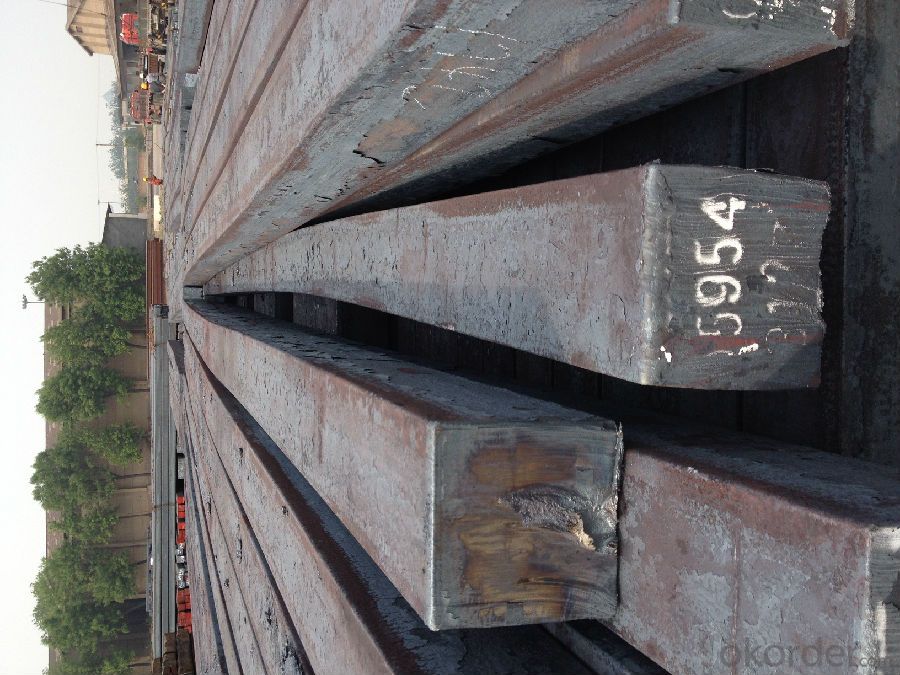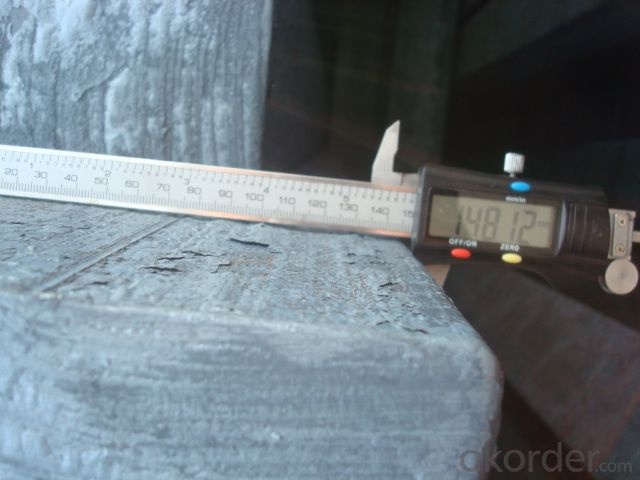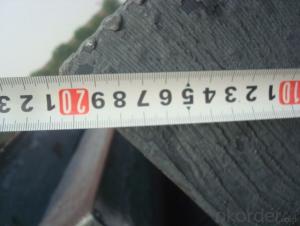Steel Billet Hot Rolled in Amazing Prices
- Loading Port:
- Tianjin
- Payment Terms:
- TT OR LC
- Min Order Qty:
- 1000 m.t.
- Supply Capability:
- 50000 m.t./month
OKorder Service Pledge
OKorder Financial Service
You Might Also Like
1.Structure of Steel Billet
Steel billet(ingot) by cogging or breakdown of semi-finished products, is the raw material of all kinds of steel mill. Billet section of square, round, flat, rectangular and abnormity of several kinds of, mainly related to the shape of rolled products.
2.Main Features of Steel Billet
Rectangular billet continuous casting billet and mainly general carbon steel, low carbon low silicon cold-rolled material, high quality carbon structural steel, high strength low alloy steel, special steel, etc.
The billet is mainly divided into two kinds from the shape:
Slab: cross section width and height of the ratio of the larger, mainly used for rolling plate.
Billet: equal cross section width and height, or a huge difference, mainly used for rolling steel, wire rod. ,
Steel billets have distinct characteristics as compared with already furnished steel bars and products. Billets have a specific grain structure, which enables the metal to be processed more intricately. Steel billets are also known for their malleability and ductility, especially when exposed to varying temperatures during shaping and molding.
3.Processing of Steel Billet
Steel billets are considered fresh and raw, and they must undergo a series of manufacturing processes before they can be used for various purposes. Billets are made by means of freezing molten liquid, and are later exposed to extremely low temperatures in order to allow the metal to take shape and solidify in chemical structure. The temperature manipulates the metal's physical properties, and tones its strength and durability. The subsequent processes provide the metal's curved mold design so that it can fit the allotted space provided by other machines, which complete the finishing procedures.
4.Steel Billet Images


5. Steel Billet Specification
Hot rolled billet steel
Size: 50x50mm-180x180mm
Steel Grade: 3SP, 5SP,Q195,Q235,Q255,Q275 Length:3m-12m
MOQ: 1000MT/size
Payment term: TT or LC
Packing: in bulk , bundle
Shipment: by container , bulk vessel
Packaging Details: bundles with steel strips or as customers's requirements
Delivery time: 15-30 days after the deposit
Loading port:Tianjin, or other port China
Origin :China
Inspection:Third party inspection before loading.
6.FAQ
We have organized several common questions for our clients,may help you sincerely:
1) How to guarantee the quality of the products?
We have established the international advanced quality management system,every link from raw material to final product we have strict quality test;We resolutely put an end to unqualified products flowing into the market. At the same time, we will provide necessary follow-up service assurance.
2) How long can we receive the product after purchase?
In the purchase of product within three working days, We will arrange the factory delivery as soon as possible. The pecific time of receiving is related to the state and position of customers.Commonly 7 to 10 working days can be served.
I want to order some goods with small qty. but more varieties, can you accept the order?
A: Would you pls send the qty. of each model to us by email? We will check it and reply you soon.
- Q:How are steel billets used in the manufacturing of rail tracks?
- Steel billets are an essential component in the manufacturing of rail tracks. A billet is a semi-finished piece of steel that is commonly used as a starting material in various metalworking processes. In the case of rail track manufacturing, steel billets are first heated to a high temperature and then passed through a series of rolling mills. During the rolling process, the steel billets are gradually shaped and elongated to form long, narrow sections known as rail blooms. These rail blooms are then further processed and shaped through hot rolling, where they are passed through multiple sets of rollers to achieve the desired dimensions and shape of the rail track. This process helps in improving the mechanical properties of the steel, such as its strength and durability. Once the rail blooms are shaped, they undergo a process called controlled cooling, where they are cooled at a specific rate to optimize their microstructure and properties. This controlled cooling helps in reducing internal stresses and improving the overall quality of the rail tracks. After the controlled cooling process, the rail blooms are further processed through straightening, cutting, and finally, finishing operations. These operations ensure that the rail tracks are straight, have precise dimensions, and meet the required standards and specifications. In summary, steel billets play a crucial role in the manufacturing of rail tracks. They are transformed into rail blooms through a series of rolling processes, and then further processed to produce high-quality rail tracks that are strong, durable, and able to withstand the heavy loads and constant use of railway transportation systems.
- Q:What are the typical dimensions and weight of steel billets?
- The typical dimensions and weight of steel billets can vary depending on the specific requirements of the industry or application. However, in general, steel billets are rectangular in shape and have a length that is several times its width and height. The dimensions of steel billets commonly range from around 100mm to 200mm in width, 100mm to 300mm in height, and 3,000mm to 6,000mm in length. These dimensions can vary based on the intended use, as different industries may have specific requirements for their steel billets. Regarding weight, steel billets typically range from a few hundred kilograms to several metric tons. The weight depends on various factors, including the dimensions, density, and grade of steel used. It is important to note that steel billets can be customized to meet specific weight requirements, especially in industries such as construction, automotive, and manufacturing, where precise weight specifications are necessary. Overall, the dimensions and weight of steel billets can vary based on industry needs, but they generally adhere to rectangular shapes and can range from hundreds of kilograms to several metric tons.
- Q:Can steel billets be used for making hand tools?
- Yes, steel billets can be used for making hand tools. Steel billets are the initial form of steel that can be shaped and processed into various products, including hand tools. The billets can be heated, forged, and machined to create durable and reliable hand tools that can withstand the rigors of daily use.
- Q:How do steel billets contribute to the overall corrosion protection of a structure?
- Steel billets, classified as semi-finished steel products, play a crucial role in safeguarding structures against corrosion. They contribute to corrosion protection through multiple means: 1. Superior steel composition: Steel billets are crafted from top-notch steel that comprises different alloying elements, like chromium, nickel, and molybdenum. These elements amplify the steel's resistance to rust and corrosion, making it less vulnerable. 2. Protective layering: Steel billets are often coated with protective layers, such as zinc or epoxy coatings. These coatings function as a barrier between the steel surface and the external environment, obstructing moisture, oxygen, and other corrosive substances from reaching the steel and causing corrosion. 3. Enduring strength: Steel billets are renowned for their remarkable strength and durability. When utilized in construction, they provide a robust foundation and structural support. This strength and durability minimize the likelihood of structural damage and corrosion, guaranteeing the stability and longevity of the structure. 4. Welding capability: Steel billets possess exceptional weldability, facilitating easy and efficient joining of steel components during construction. Proper welding techniques and materials can further augment the structure's corrosion resistance by preserving the integrity and continuity of the protective coatings. 5. Maintenance and repair: In the event of damage or corrosion on the structure, steel billets can be readily replaced or repaired. This ensures that the affected area can be rectified without compromising the overall integrity and corrosion protection of the structure. Regular maintenance and repair of steel billets contribute to the long-term corrosion protection of the entire structure. In conclusion, steel billets contribute significantly to the overall corrosion protection of structures through their high-quality composition, protective coatings, durability, weldability, and ease of maintenance and repair. By incorporating steel billets into construction projects, engineers and architects can ensure the longevity, safety, and corrosion resistance of structures in diverse environments.
- Q:What is the melting point of steel billets?
- The melting point of steel billets can vary depending on the type of steel being used. Generally, the melting point of steel ranges from 1370 to 1530 degrees Celsius (2500 to 2800 degrees Fahrenheit). However, it is important to note that different grades and compositions of steel can have slightly different melting points. Additionally, the melting point can also be influenced by other factors such as impurities, alloying elements, and the presence of other metals in the steel. Therefore, it is always recommended to refer to the specific material specifications or consult with metallurgical experts for precise information on the melting point of steel billets.
- Q:How do steel billets contribute to the energy efficiency of a structure?
- There are several ways in which steel billets contribute to the energy efficiency of a structure. Firstly, steel billets are a primary raw material for producing structural steel, which is known for its high strength-to-weight ratio. This quality allows steel structures to bear heavy loads without needing excessive amounts of material. As a result, structures made of steel are lighter and more energy efficient. The reduced weight leads to lower transportation costs and less energy consumption during construction. Moreover, steel billets can be easily molded and shaped into different forms, enabling the design and construction of more efficient and streamlined structures. The flexibility of steel as a construction material empowers engineers and architects to create innovative designs that maximize energy efficiency. For instance, steel can be used to construct long-span structures, which reduces the need for additional support columns and optimizes natural lighting and ventilation. Consequently, this decreases the reliance on artificial lighting and HVAC systems. Additionally, steel is highly durable and requires minimal maintenance throughout its lifespan. This durability not only extends the life of the structure but also reduces the energy and resources needed for repairs and replacements. Steel structures also possess excellent fire resistance properties, which contributes to energy efficiency by minimizing fire-related damages and the subsequent energy consumption associated with rebuilding or repairing. Lastly, steel is highly recyclable. At the end of a structure's life, steel components can be salvaged and recycled easily, decreasing the demand for new steel production and conserving natural resources. The recycling process for steel is energy-efficient compared to the production of new steel, further reducing the carbon footprint of the structure. In conclusion, steel billets enhance the energy efficiency of a structure through their high strength-to-weight ratio, design flexibility, durability, fire resistance, and recyclability. These properties enable the construction of lighter, more efficient structures that require less energy during construction, operation, and maintenance. Consequently, they minimize environmental impact.
- Q:What are the different types of coating processes used for protecting steel billets?
- Steel billets can be protected using various coating processes. These processes serve the purpose of preventing corrosion and enhancing the durability of the steel billets. Some commonly employed coating methods are as follows: 1. Hot-dip galvanizing: In this technique, the steel billets are immersed in molten zinc, creating a safeguarding layer on the surface. This zinc layer ensures long-lasting protection against corrosion. 2. Electroplating: By using an electric current, a thin layer of metals like zinc, nickel, or chrome is deposited onto the steel billets. This metal coating acts as a barrier against corrosion while improving the appearance of the steel. 3. Powder coating: A dry powder is applied to the steel billets and then heated, resulting in the formation of a protective layer. This process offers exceptional resistance against corrosion, chemicals, and UV rays. 4. Thermal spray coating: This method involves spraying melted or heated materials onto the steel billets. The coating materials can include metal alloys, ceramics, or polymers. Thermal spray coatings provide excellent wear resistance, corrosion protection, and thermal insulation. 5. Paint coating: Applying paint onto the steel billets is a popular protective measure. The paint acts as a barrier, preventing moisture and atmospheric elements from causing corrosion while maintaining the steel's appearance. Each coating process has its own advantages and is suitable for different applications. The choice of coating method depends on factors such as the desired level of protection, environmental conditions, and cost considerations.
- Q:How is the market for steel billets influenced by global economic trends?
- The market for steel billets is significantly influenced by global economic trends. Fluctuations in the global economy directly impact the demand and pricing of steel billets. During periods of economic growth, the demand for steel increases as construction and infrastructure projects surge, leading to higher prices for steel billets. Conversely, during economic downturns, the demand for steel declines, resulting in lower prices for steel billets. Additionally, changes in global trade policies and regulations can also impact the market, affecting the supply and demand dynamics for steel billets worldwide.
- Q:What are the different surface treatment methods used for steel billets?
- Some of the different surface treatment methods used for steel billets include shot blasting, pickling, and galvanizing. Shot blasting involves propelling steel shots at high speeds to remove any mill scale or surface impurities. Pickling involves immersing the billets in an acid solution to remove any oxide layers and create a clean surface. Galvanizing involves coating the billets with a layer of zinc to provide corrosion resistance. Other methods such as painting, phosphating, and powder coating may also be used for specific applications.
- Q:What are the main types of steel billet rolling mills?
- The main types of steel billet rolling mills include continuous, semi-continuous, and reversing mills.
1. Manufacturer Overview |
|
|---|---|
| Location | |
| Year Established | |
| Annual Output Value | |
| Main Markets | |
| Company Certifications | |
2. Manufacturer Certificates |
|
|---|---|
| a) Certification Name | |
| Range | |
| Reference | |
| Validity Period | |
3. Manufacturer Capability |
|
|---|---|
| a)Trade Capacity | |
| Nearest Port | |
| Export Percentage | |
| No.of Employees in Trade Department | |
| Language Spoken: | |
| b)Factory Information | |
| Factory Size: | |
| No. of Production Lines | |
| Contract Manufacturing | |
| Product Price Range | |
Send your message to us
Steel Billet Hot Rolled in Amazing Prices
- Loading Port:
- Tianjin
- Payment Terms:
- TT OR LC
- Min Order Qty:
- 1000 m.t.
- Supply Capability:
- 50000 m.t./month
OKorder Service Pledge
OKorder Financial Service
Similar products
New products
Hot products
Hot Searches
Related keywords






























